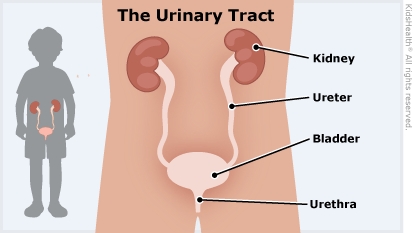After Getting a VCUG: How to Care for Your Child
A voiding cystourethrogram (VCUG) is a test that shows parts of the urinary system and if a child has vesicoureteral reflux (VUR). In kids with VUR, some of the urine (pee) flows backward from the bladder into one or both ureters and kidneys. Sometimes after a VCUG, a child has mild discomfort or stinging when peeing. This usually gets better quickly. In the meantime, you can help your child feel more comfortable.


-
As long as your child feels well, he or she can return to normal activities right away.
-
Encourage your child to drink plenty of fluids.
-
Sitting in a warm water bath (no bubble bath or soap) may help your child feel more comfortable.
-
If your child is uncomfortable, acetaminophen (such as Tylenol® or a store brand) may help if recommended by your health care provider.

Your child has:
-
belly pain or seems uncomfortable
-
a fever of 101°F (or 38.3°C) or higher
-
trouble peeing
-
pain or burning when peeing more than 1 day after the VCUG
-
blood in the pee more than 1 day after the VCUG
-
strong-smelling pee or pee that looks cloudy or thick

Your child:
-
cannot pee at all
-
appears dehydrated; signs include dizziness, drowsiness, a dry or sticky mouth, sunken eyes, crying with few or no tears, or peeing less often (or having fewer wet diapers)

How was the VCUG done? The person doing the VCUG placed a small soft tube (called a catheter) through the urethra (where the pee comes out) and into the bladder. He or she then put a liquid (called contrast) into the bladder through the catheter. This liquid helps to make the parts of the urinary system easier to see on an X-ray.
A special camera (called a fluoroscope) took X-rays of the bladder, kidneys, ureters (the tubes connecting the kidneys and bladder), and urethra. The X-rays were taken while the liquid was in the bladder and also while your child peed.
Why is it important to know if my child has VUR? VUR can lead to kidney infections and kidney damage if not treated.